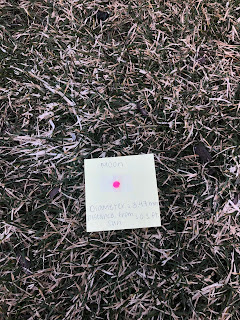Week 7: Solar System
Lab
WEEK 7: SOLAR SYSTEM
Our Solar System
The Milky Way
Galaxy: a collection of billions of stars, gas, and dust held together by gravity in space
Solar System: located in the Milky Way Galaxy
The Milky Way is a large spiral-shaped galaxy which contains hundreds of billions of stars
At the center of the Milky Way is a supermassive black hole named Sagittarius A (mass of 4 million suns)
Our Sun, Earth, and planets are located halfway between the center and the outer edge on a small partial arm called the Orion Spur
There are 8 planets in our solar system:
Mercury
Venus
Earth
Mars
Jupiter
Saturn
Uranus
Neptune
ACRONYM (closest to farthest from the sun) = My Very Educated Mother Just Served Us Nutella
Four inner planets (Mercury, Venus, Earth, Mars) are rocky planets because they have a solid surface
Four outer planets (Jupiter, Saturn, Uranus, Neptune) are gaseous planets because they are composed of gases, mainly hydrogen & helium
Rocky planets are much smaller in size, gaseous planets are larger
Theory for this: when the Sun turned on and became a star, it caused the gas clouds of the 4 inner planets to blow away and the rocky planets were left with a smaller, solid planet
Gaseous planets are farther from the sun, so they retained their composition
As they increased in mass = gravity increased = allowed them to attract more and more material from space and grow larger in size
Why is Pluto not a planet?
Was the 9th planet in our solar system until 2006 decision to be a dwarf planet
Meets the 2 requirements to be a planet:
Orbits around the sun
Its gravity formed the planet into a round shape
Does not meet the 3rd requirement:
Clearing the neighborhood
Planets must have gravitational dominance and clear the neighborhood around their orbit
Means that large planets (more mass = more gravity) either attract or eject other, smaller bodies from that region of space
Several other dwarf planets and similarly-sized space objects were discovered in the solar system near Pluto’s orbit in the Kuiper Belt, so Pluto has not cleared the neighborhood & cannot be considered a planet
Asteroids
Dust & rocks in space were pulled together by gravity to form planets
Rocky remnants (that didn’t make it into a planet) called asteroids remain and orbit the sun in our solar system
Main asteroid belt = between Mars & Jupiter, where most known asteroids orbit
Other objects in the Solar System
Comet: A frozen ball of gas, rock, and dust that orbit the Sun. When a comet gets close to the Sun, it heats up and the gas and dust form a tail.
Meteoroid: A small rock in space that orbits around the Sun. Most meteors have broken off of larger objects such as asteroids or comets. They can be as small as a grain of sand or as large as a pickup truck.
Meteor: The streak of light that is caused when a meteoroid enters Earth’s atmosphere and burns up due to friction. Also known as a shooting star.





Comments
Post a Comment